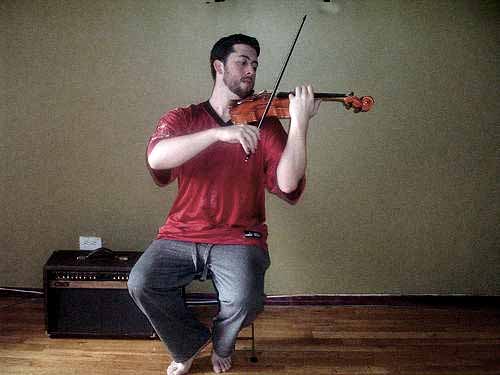There are two different general approaches to violin amplification: Removable pickups that the musician can put on themselves, and permanent pickups, which must be installed by a professional. Whichever approach you choose, one of the best violin pickups that we reviewed below can fill your amplification needs.
Headway The Band Pickup System
This pickup system is designed to be easy to install without requiring any modifications to your instrument—perfect for players who want to use their concert violin in an amplified setting. The pickup system wraps around your instrument’s body, snugly enough to stay in place but without any stress or scratches to the wood.
The pickup (see full specs) gives you a truer and cleaner sound reproduction than using a microphone, letting you get more volume without any feedback along with reducing extraneous noise from your bow and body. The result is a clear, warm tone from a pickup that can be plugged directly into an amplifier or mixing desk, making it a versatile pickup that’s useful in both stage and studio applications.
Mighty Mini
Another excellent option in the easy to install violin pickup market is the Mighty Mini. It attaches to the afterlength of the strings, meaning it never even has to come into contact with the body of your violin and there’s no threat of even superficial damage to the lacquer. It’s as easy to put on as it is to remove, perfect for sound checks or quick switches between acoustic and electric play. It works for any stringed instrument, from orchestral instruments like cello and violin to folk instruments like mandolin and ukulele, making it one of the best violin pickups for teachers or recording engineers who may need to amplify a variety of instruments.
LR Baggs Violin Pickup
For a more permanent pickup solution, you can’t go wrong with this LR Baggs model. They’re the most trusted brand for bridge pickups across the industry, known for their ability to amplify the true natural sound of your violin without pesky feedback or the thin, nasal tone and extra noise you can get when playing into a microphone.
The transducer is cast directly into the bridge to give you remarkable sensitivity across dynamics, with a balanced tone across the strings that enhances rather than alters the natural tonal qualities of your instrument. There’s a reason this pickup is the most common choice of professional fiddle players. Once installed, it’ll deliver a consistent, natural tone whether you’re recording or playing live, making worries over amplification a thing of the past. Just check out the video below (yes, she’s using the LR Baggs violin pickup, which she explains after the “hot pirate chicks” intro).
Myers The Feather Micro Goose-neck Pickup
The Feather by Myers is the smallest all in one active preamp and pickup available for today’s violinist. It’s exceptionally versatile and is ready to go out of the box with no costly, permanent modifications. It comes with a Lithium battery pre-installed for power, while the included preamp adds richness and warmth to your tone.
The pickup (see full specs) is compatible with most effects pedals, for players looking to add a bit of extra color to their sound, and is so small and lightweight that it won’t alter or dampen your instrument’s sound, wherever you install it. The patented saddle clip mounting hardware is guaranteed to stay in place for your whole gig without leaving a mark on your violin. Hands down, it’s one of the best violin pickups on the market.
Removable Versus Permanent Pickups
The first decision you should make when picking out a violin pickup is whether you want to have one permanently installed or whether you’d like to be able to remove it at will. Permanent pickups have the obvious advantage of convenience—once it’s installed, all you have to do is plug in. It also tends to be more stable and give you a more consistent sound every time you play.
The main thing that puts people off from a permanent pickup is the fact that it means replacing the bridge. Many players are understandably dubious about swapping out their bridge because of the way this may change their acoustic tone. If you will primarily be playing your instrument using amplification, however, a permanent pickup is often the best way to go.
When it comes to removable pickups, you have a lot of options in terms of how they’re mounted to your instrument. The less contact the pickup has with the body of your violin, generally speaking, the less it’s likely to dampen or otherwise impact your sound. The main issues players tend to have with removable pickups is that they can be time-consuming to attach and remove and may give you inconsistent sound if you don’t use the exact same placement each time you install it. Vibrations from your instrument can also shift the pickup or even jar it loose if it’s not attached securely enough.
Generally, though, these issues will get less troublesome as you grow accustomed to the pickup and figure out how to best fit it on your instrument. If you’re wary of making any modifications to your violin, removable pickups can give you the same sound quality and leave no lasting impact, and are definitely the way to go.
Selecting the Best Violin Pickups – Passive Versus Active
The main difference between a passive and an active pickup is whether or not it has an active preamp. A passive pickup is basically a transducer comprised of wire coils wrapped around a magnet. An active pickup also uses circuitry to boost the signal. This circuitry requires more power than a transducer, meaning that active pickups need to have a power source, usually a battery.
In practice, passive pickups are more prone to interference and extra noise, and can be sensitive to feedback. Active pickups are naturally much quieter, but aren’t as sensitive to subtle shifts in dynamic or touch. Generally speaking, a passive pickup will have better low-end response and not as much detail in the higher frequencies, which can give your instrument an overall warmer tone.
If you’re a classical violinist, the dynamic subtlety allowed by passive pickups makes them generally a better choice. Because the music is generally quieter, you’ll be less likely to have to worry about feedback. If you play more bluegrass and folk, either a passive or an active pickup could be a good option.








